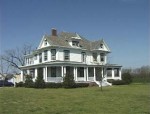August 26, 2006 marked a major step forward for the Virginia Coast Reserve Long-Term Ecological Research (VCR LTER) project, with the opening of a new laboratory and housing facility. The Anheuser-Busch Coastal Research Center (ABCRC) of the University of Virginia was dedicated at a ceremony attended by 250 guests, with speeches by University of Virginia President John T. Casteen III and Anheuser-Busch representative John L. Nau III, as well VCR LTER researchers Karen J. McGlathery, Jay C. Zieman and David E. Smith.
The ABCRC replaces a rented 1927 farmhouse, retrofitted as a laboratory and housing facility, which had served as the field home for VCR researchers since 1986. Although the house served the program well, it had numerous deficiencies, such as poor climate control, lack of space designed for laboratories, and a limited number of rooms for housing visitors, often requiring five or more people to share a room.
The new facility is a dramatic improvement, with separate buildings for laboratory and housing functions, full climate control, and apartments that can be configured with 1-5 bedrooms to accommodate groups of different sizes.
The ABCRC is located on 17 ha at the harbor at Oyster, Virginia. The laboratory building includes 9,369 square feet of dry and wet lab space, divided into eight wet laboratories, two dry laboratories, three offices and a conference room capable of hosting meetings of up to 50 individuals. Laboratory amenities include fume hoods, deionized water, vacuum, standard and ultracold (-80° C) freezers, drying ovens, muffle furnaces, microscopes, and freeze-drying facilities. The ABCRC operates several boats in the 18-24 feet size range for transporting researchers and samples. The ABCRC dock has room for up to 10 boats and is adjacent to a county boat ramp. A 5,767 sq. ft. housing unit has 11 bedrooms, most equipped with three beds, three fully-equipped kitchens with laundry facilities, and five bathrooms.
All ABCRC buildings and grounds are fully networked via a 100 Mbs intranet with an internal 11-54 Mbs wireless network. Wireless networks at major ABCRC research sites up to 30 plus kilometres (about 19 miles) away (e.g., Hog Island) provide real-time access to field monitoring equipment at speeds between 3 and 54 Mbs. The landscape, with subtle topographic gradients and large areas of low vegetation, are ideal for using spread-spectrum wireless networking in the field.
Funding for the ABCRC came primarily from private sources. The Anheuser-Busch Foundation provided $1.2 million, Paul Tudor Jones provided an additional $1 million and the National Science Foundation provided an additional $305,000. This is the first phase of building the ABCRC; site preparation work is complete for three additional buildings, including additional laboratory and housing facilities and a conference center.
Photos of the construction can be viewed online at: http://amazon.evsc.virginia.edu/gallery23/main.php/v/ABCRC_Construction/

 Enlarge this image
Enlarge this image
